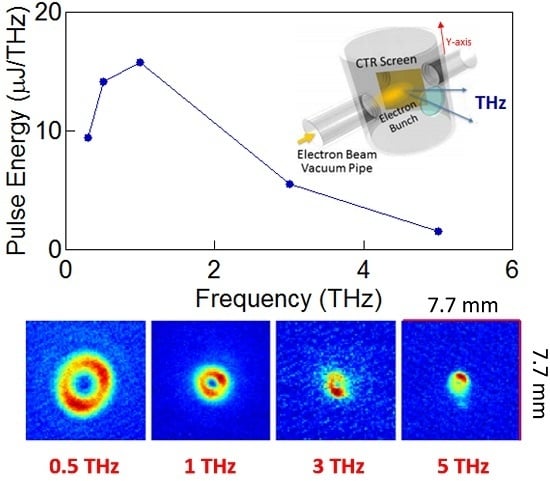Tailoring of Highly Intense THz Radiation Through High Brightness Electron Beams Longitudinal Manipulation
Abstract
:1. Introduction
2. Theoretical Background
3. THz Source Experimental Layout
4. Results and Discussion
4.1. Broadband Generation
4.2. Spectral-Shaped THz Generation
5. Figures of Merit
6. Conclusions
Acknowledgments
Author Contributions
Conflicts of Interest
References
- Wu, Z.; Fisher, A.S. Intense terahertz pulses from SLAC electron beams using coherent transition radiation. Rev. Sci. Instr. 2013, 84. [Google Scholar] [CrossRef] [PubMed]
- Stojanovic, N.; Drescher, M. Accelerator- and laser-based sources of high-field terahertz pulses. J. Phys. B: Atomic Mol. Opt. Phys. 2013, 46. [Google Scholar] [CrossRef]
- Lee, Y.R. Principles of Terahertz Science and Technology; Springer Science + Business Media LLC: New York, NY, USA, 2009; pp. 59–74. [Google Scholar]
- Zhu, B.; Chen, Y.; Deng, K.; Hu, W.; Yao, Z.S. Terahertz science and technology and applications. In Proceedings of the Progress in Electromagnetics Research Symposium, Beijing, China, 23–27 March 2009; pp. 1166–1170.
- Yeh, K.L.; Hoffmann, M.C.; Hebling, J.; Nelson, K.A. Generation of 10 μJ ultrashort terahertz pulses by optical rectification. Appl. Phys. Lett. 2007, 90. [Google Scholar] [CrossRef]
- Vicario, C.; Monoszlai, B.; Hauri, C.P. GV/m single-cycle terahertz fields from a laser-driven large-size partitioned organic crystal. Phys. Rev. Lett. 2014, 112. [Google Scholar] [CrossRef]
- Ferrario, M.; Alesini, D.; Anania, M.; Bacci, A.; Bellaveglia, M.; Bogdanov, O.; Boni, R.; Castellano, M.; Chiadroni, E.; Cianchi, A.; et al. SPARC_LAB present and future. Nucl. Instrum. Methods Phys. Res. B 2013, 309, 183–188. [Google Scholar] [CrossRef] [Green Version]
- Chiadroni, E.; Bacci, A.; Bellaveglia, M.; Boscolo, M.; Castellano, M.; Cultrera, L.; di Pirro, G.; Ferrario, M.; Ficcadenti, L.; Filippetto, D.; et al. The SPARC linear accelerator based terahertz source. Appl. Phys. Lett. 2013, 102. [Google Scholar] [CrossRef] [Green Version]
- Serafini, L.; Ferrario, M. Velocity bunching in photo-injectors. AIP Conf. Proc. 2001, 581. [Google Scholar] [CrossRef]
- Ferrario, M.; Alesini, D.; Bacci, A.; Bellaveglia, M.; Boni, R.; Boscolo, M.; Castellano, M.; Chiadroni, E.; Cianchi, A.; Cultrera, L.; et al. Experimental Demonstration of Emittance Compensation with Velocity Bunching. Phys. Rev. Lett. 2010, 104. [Google Scholar] [CrossRef] [PubMed]
- Ferrario, M.; Alesini, D.; Bacci, A.; Bellaveglia, M.; Boni, R.; Boscolo, M.; Castellano, M.; Chiadroni, E.; Cianchi, A.; Cultrera, L.; et al. Laser comb with velocity bunching: Preliminary results at SPARC. Nucl. Instr. Methods Phys. Res. Sect. A: Accel. Spectrom. Detect. Assoc. Equip. 2011, 637, S43–S46. [Google Scholar] [CrossRef]
- Chiadroni, E.; Bellaveglia, M.; Calvani, P.; Castellano, M.; Catani, L.; Cianchi, A.; di Pirro, G.; Ferrario, M.; Gatti, G.; Lupi, S.; et al. Characterization of the THz radiation source at the Frascati linear accelerator. Rev. Sci. Instrum. 2013, 84. [Google Scholar] [CrossRef] [PubMed] [Green Version]
- Gensch, M.; Bittner, L.; Chesnov, A.; Delsim-Hashemi, H.; Drescher, M.; Faatz, B.; Feldhaus, J.; Fruehling, U.; Geloni, G.A.; Gerth, Ch.; et al. New infrared undulator beamline at FLASH. Infrared Phys. Technol. 2008, 51, 423–425. [Google Scholar] [CrossRef]
- Cook, A.M.; Tikhoplav, R.; Tochitsky, S.Y.; Travish, G.; Williams, O.B.; Rosenzweig, J.B. Observation of Narrow-Band Terahertz Coherent Cherenkov Radiation from a Cylindrical Dielectric-Lined Waveguide. Phys. Rev. Lett. 2011, 103. [Google Scholar] [CrossRef] [PubMed]
- Shen, Y.; Yang, X.; Garr, G.L.; Hidaka, Y.; Murphy, J.B.; Wang, X. Tunable Few-Cycle and Multicycle Coherent Terahertz Radiation from Relativistic Electrons. Phys. Rev. Lett. 2011, 107. [Google Scholar] [CrossRef] [PubMed]
- Muggli, P.; Yakimenko, V.; Babzien, M.; Kallos, E.; Kusche, K.P. Generation of Trains of Electron Microbunches with Adjustable Subpicosecond Spacing. Phys. Rev. Lett. 2011, 101. [Google Scholar] [CrossRef] [PubMed]
- Perucchi, A.; Baldassarre, L.; Postorino, P.; Lupi, S. Optical properties across the insulator to metal transitions in vanadium oxide compounds. J. Phys. Condensed Matter 2009, 21. [Google Scholar] [CrossRef] [PubMed]
- Calvani, P.; Capizzi, M.; Lupi, S.; Balestrino, G. Infrared active vibrational modes strongly coupled to carriers in high-Tc superconductors. Europhys. Lett. 1995, 31, 473–478. [Google Scholar] [CrossRef]
- Ferrario, M.; Alesini, D.; Alessandroni, M.; Anania, M.P.; Andreas, S.; Angelone, M.; Arcovito, A.; Arnesano, F.; Artioli, M.; Avaldi, L.; et al. IRIDE: Interdisciplinary research infrastructure based on dual electron linacs and lasers. Nuc. Instr. Methods Phys. Res. Sect. A: Accel. Spectrom. Detect. Assoc. Equip. 2014, 740, 138–146. [Google Scholar] [CrossRef]
- Rossi, A.R.; Bacci, A.; Belleveglia, M; Chiadroni, E.; Cianchi, C.; di Pirro, G.; Ferrario, M.; Gallo, A.; Gatti, G.; Maroli, C.; et al. The External-Injection experiment at the SPARC_LAB facility. Nucl. Instrum. Methods Phys. Res. Sect. A: Accel. Spectrom. Detect. Assoc. Equip. 2014, 740, 60–66. [Google Scholar] [CrossRef] [Green Version]
- Landau, L.D.; Lifschitz, E.M. Electrodynamics of Continuous Media; Pergamon Press Ltd.: Oxford, UK, 1984; pp. 410–412. [Google Scholar]
- Castellano, M.; Cianchi, A.; Orlandi, G.; Verzilov, V.A. Effect of diffraction and target finite size on coherent transition radiation spectra in bunch length measurement. Nucl. Instrum. Methods Phys. Res. A 1999, 435, 297–307. [Google Scholar] [CrossRef]
- Marchetti, B.; Bacci, A.; Chiadroni, E.; Cianchi, A.; Ferrario, M.; Mostacci, A.; Pompili, R.; Ronsivalle, C.; Spataro, B.; Zagorodnov, I. Novel schemes for the optimization of the SPARC narrow band THz source. Rev. Sci. Instrum. 2015, 86. [Google Scholar] [CrossRef] [PubMed]
- Mostacci, A.; Alesini, D.; Antici, P.; Bacci, A.; Bellaveglia, M.; Boni, R.; Castellano, M.; Chiadroni, E.; Cianchi, A.; di Pirro, G.; et al. Advanced beam manipulation techniques at SPARC. In Proceedings of the IPAC2011, THYB01, San Sebastn, Spain, 4 September 2011.
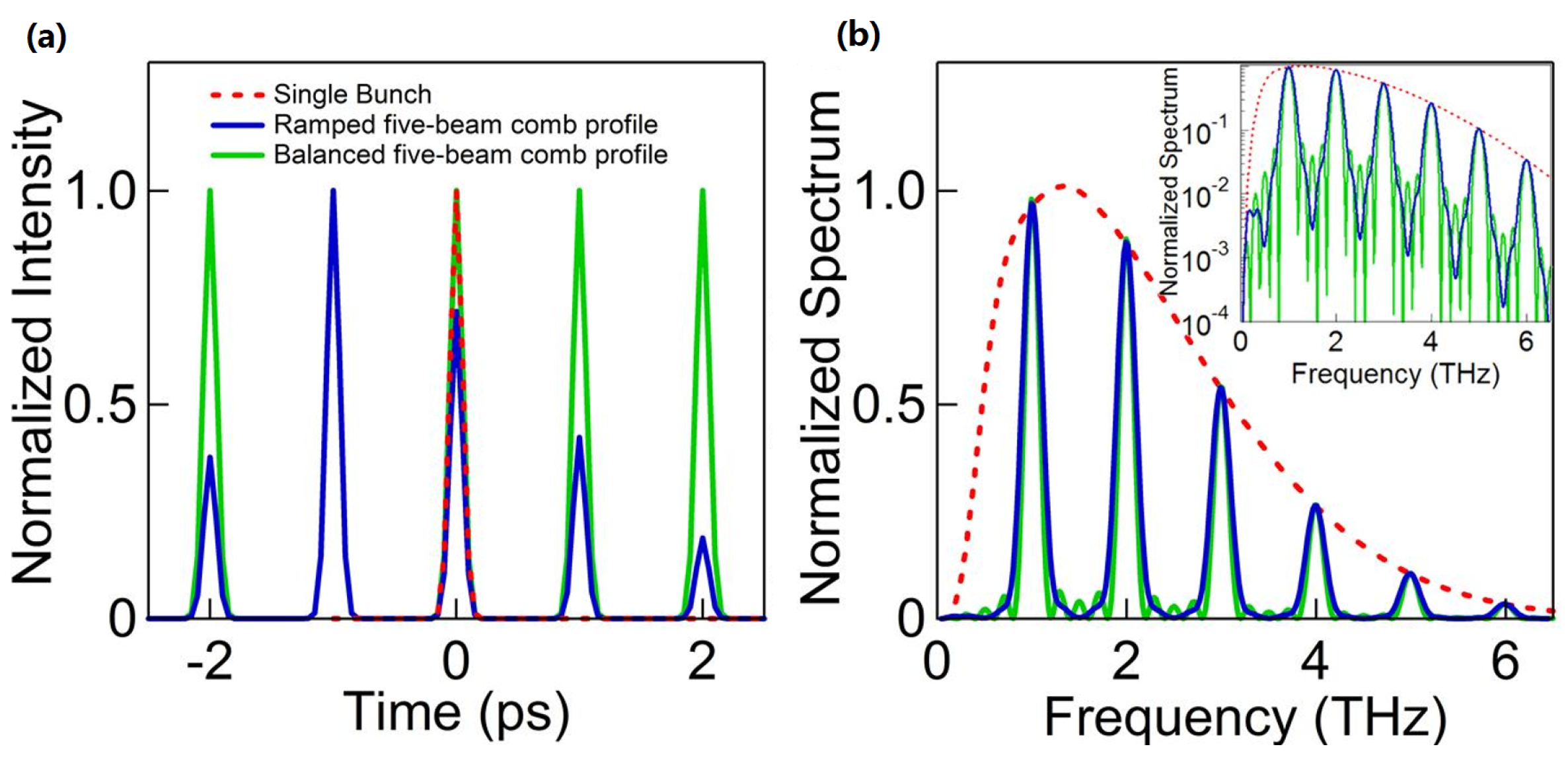

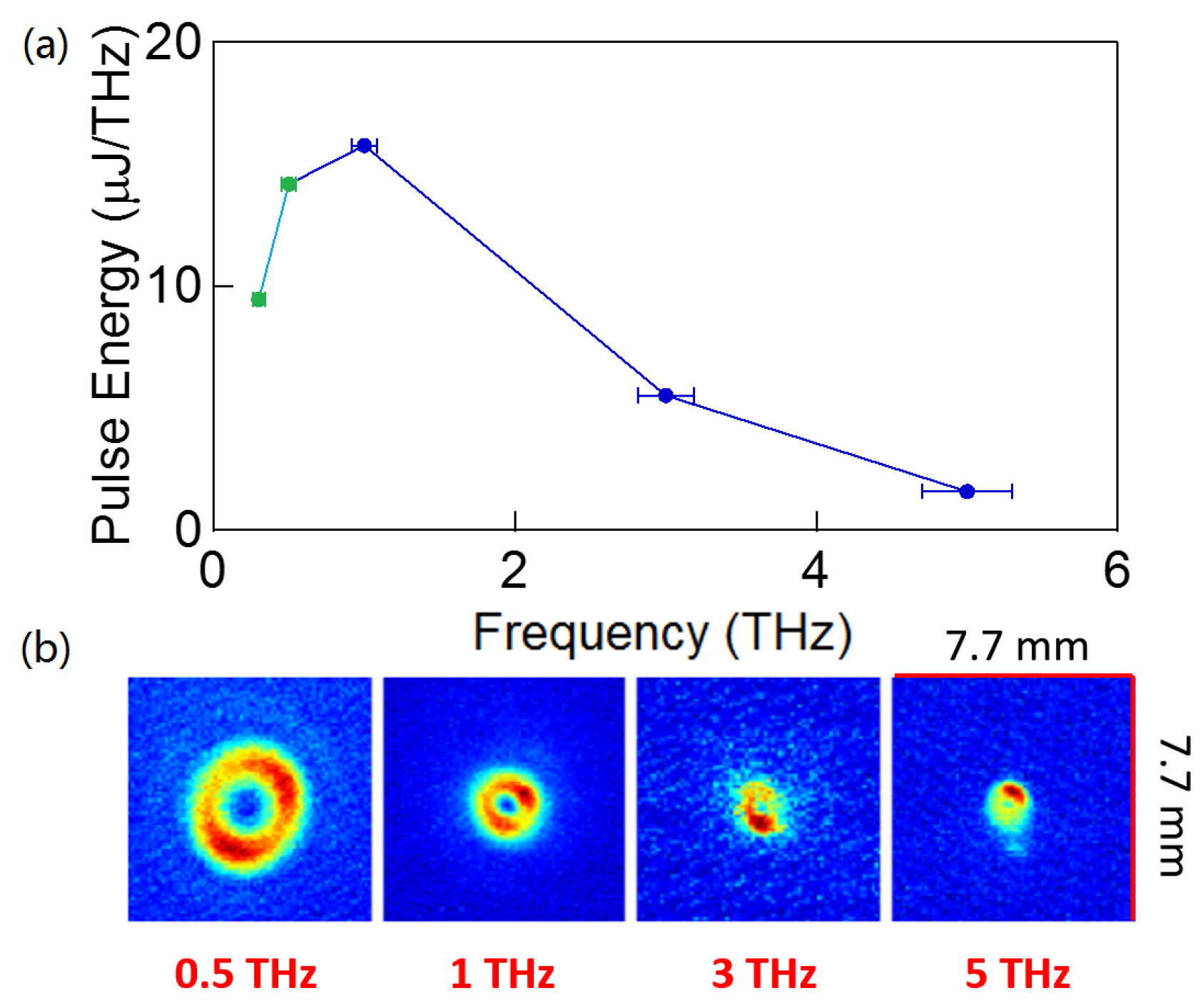
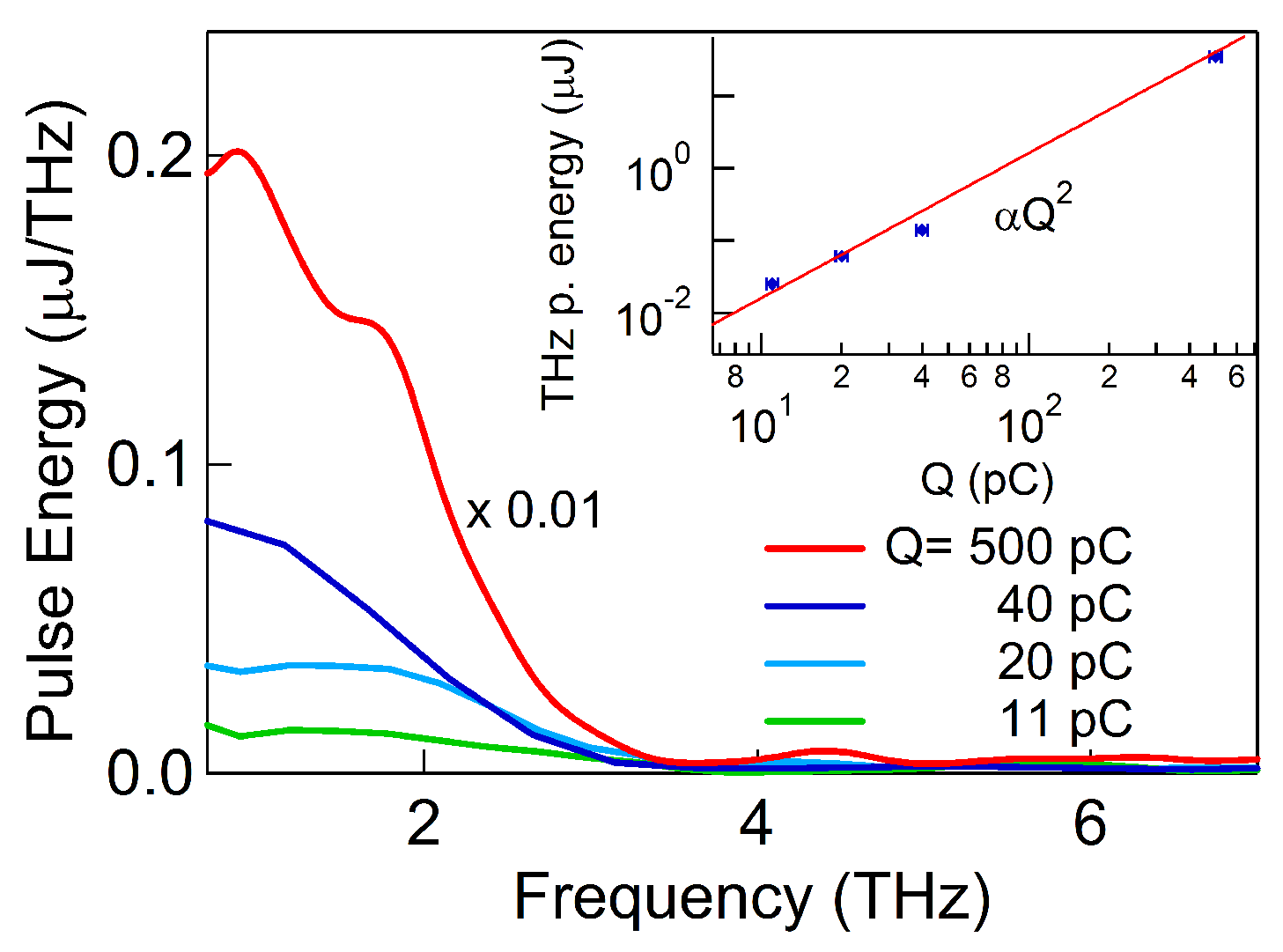
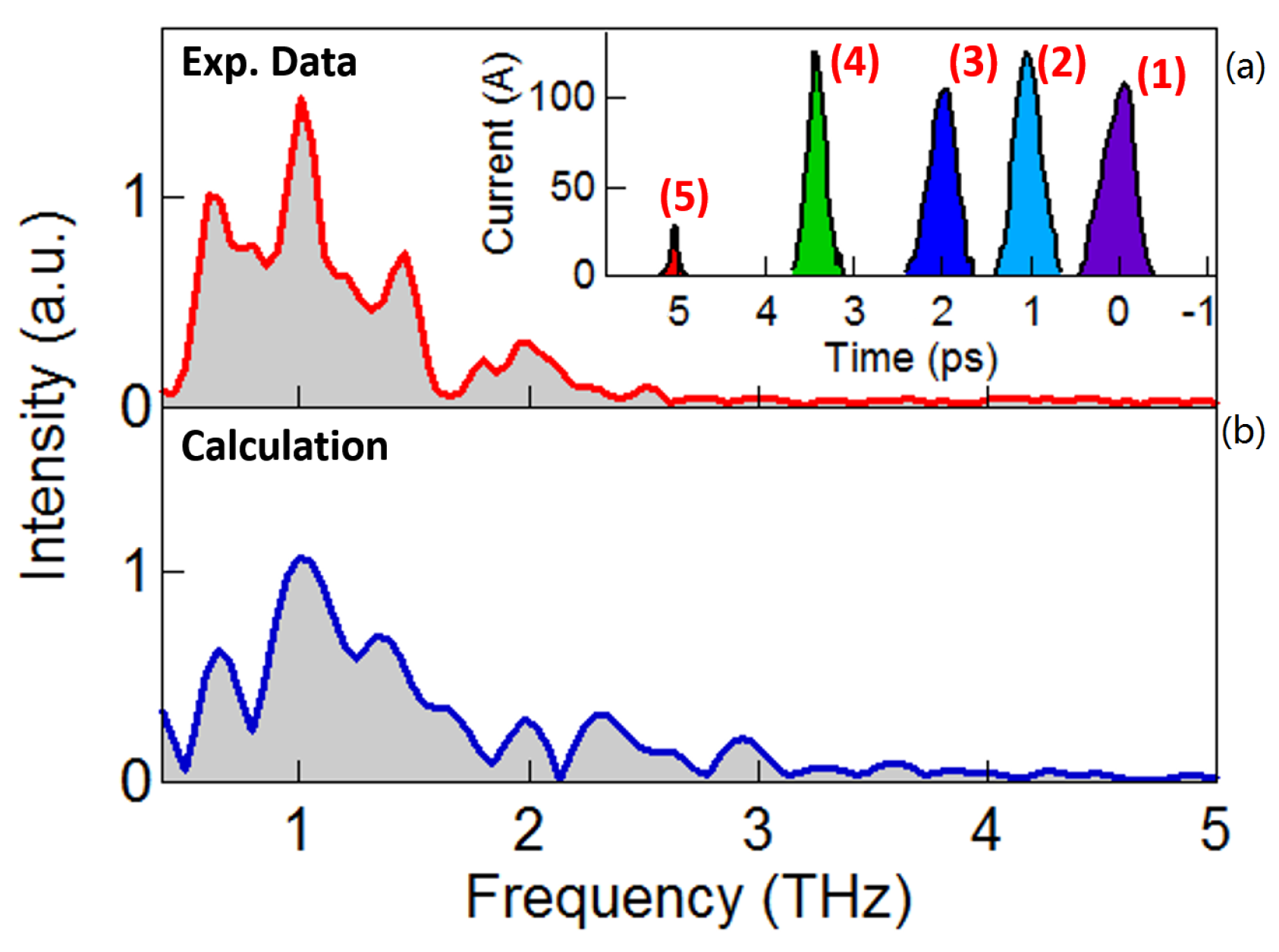
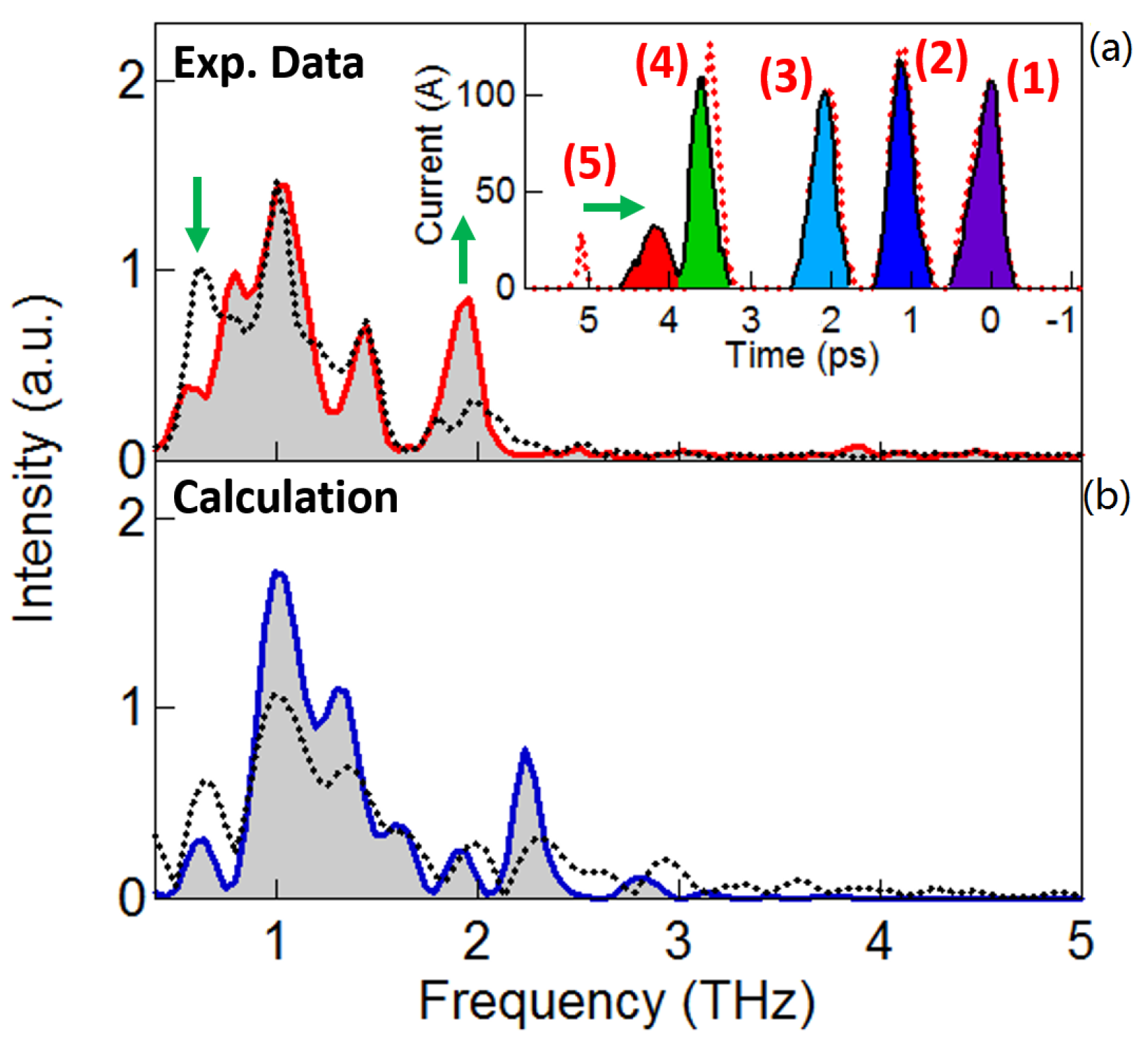
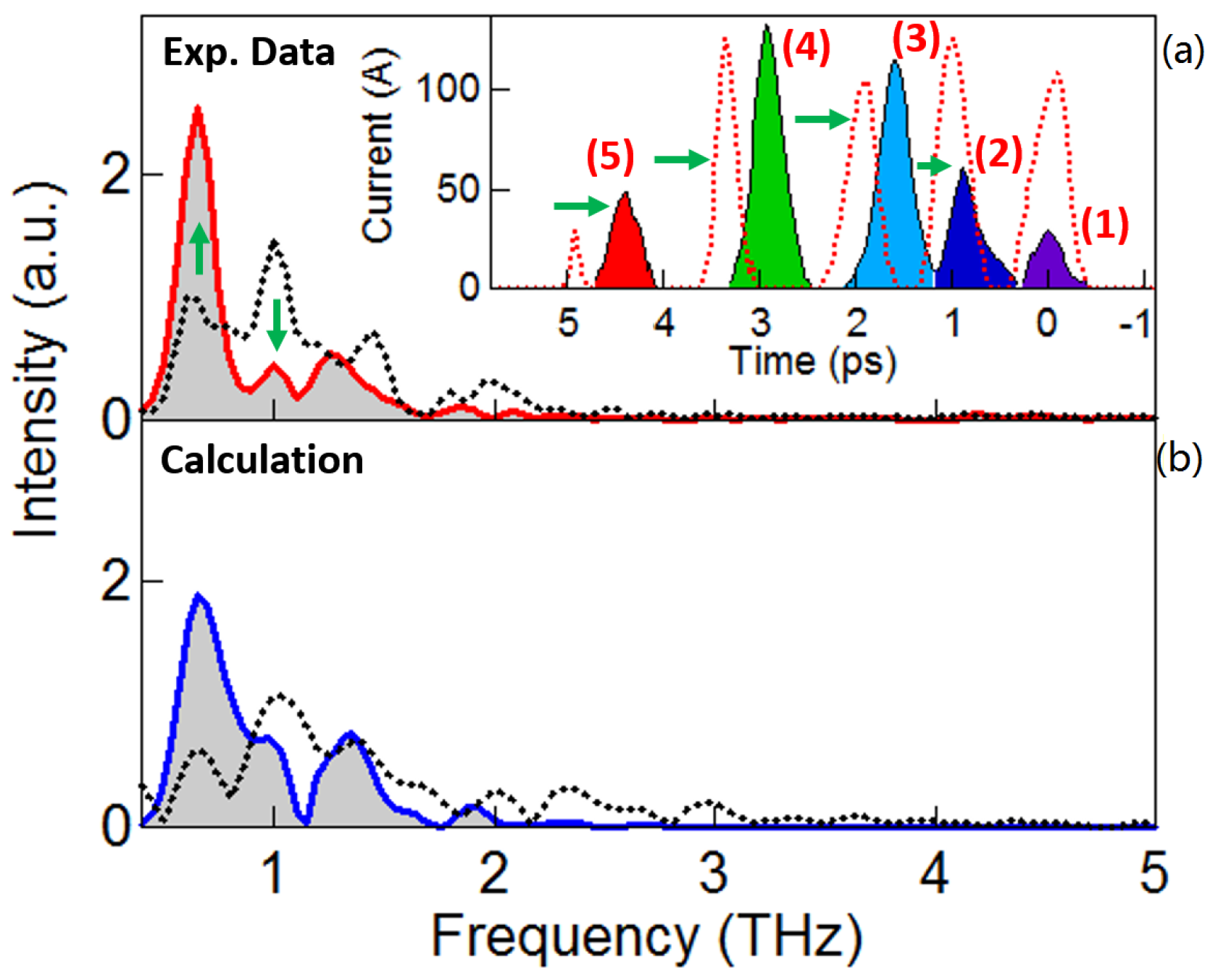
| Comb Beam 1 | Comb Beam 2 | Ramp | |||||||
|---|---|---|---|---|---|---|---|---|---|
| Inter-Distance (4)-(5) = 1.6 ps | Inter-Distance (4)-(5) = 0.5 ps | of Charge | |||||||
| Bunch | Position | Charge | Bunch | Position | Charge | Bunch | Position | Charge | |
| Lenght (ps) | (ps) | (pC) | Lenght (ps) | (ps) | (pC) | Lenght (ps) | (ps) | (pC) | |
| Beam 1 | 0.38 | 0 | 60 | 0.38 | 0 | 55 | 0.37 | 0 | 14 |
| Beam 2 | 0.32 | 0.95 | 55 | 0.32 | 1.1 | 55 | 0.56 | 0.9 | 36 |
| Beam 3 | 0.29 | 1.88 | 50 | 0.20 | 2.1 | 48 | 0.48 | 1.7 | 61 |
| Beam 4 | 0.20 | 3.5 | 50 | 0.23 | 3.6 | 46 | 0.40 | 3.0 | 85 |
| Beam 5 | 0.16 | 5.1 | 23 | 0.29 | 4.1 | 18 | 0.27 | 4.6 | 23 |
| THz Radiation Parameters | Electron Beam Parameters | ||||
|---|---|---|---|---|---|
| Single Bunch | Ramped Comb | Single Bunch | Ramped Comb | ||
| Energy per pulse (μJ) | 35 | ∼1 | Charge (pC) | 500 | 220 |
| Peak power (MW) | 0.17 | 0.25 | Energy (MeV) | 121 | 110 |
| Electric field (MV/cm) | >1 | - | Bunch duration (fs) | 180 | 130 |
| Bandwidth (THz) | >5 | 0.25 | Rep. Rate (Hz) | 10 | 10 |
| Pulse duration t (ps) | <0.1 | >1.8 * | Comb distance (ps) | - | 1.3 |
© 2016 by the authors; licensee MDPI, Basel, Switzerland. This article is an open access article distributed under the terms and conditions of the Creative Commons by Attribution (CC-BY) license (http://creativecommons.org/licenses/by/4.0/).
Share and Cite
Giorgianni, F.; Anania, M.P.; Bellaveglia, M.; Biagioni, A.; Chiadroni, E.; Cianchi, A.; Daniele, M.; Del Franco, M.; Di Giovenale, D.; Di Pirro, G.; et al. Tailoring of Highly Intense THz Radiation Through High Brightness Electron Beams Longitudinal Manipulation. Appl. Sci. 2016, 6, 56. https://doi.org/10.3390/app6020056
Giorgianni F, Anania MP, Bellaveglia M, Biagioni A, Chiadroni E, Cianchi A, Daniele M, Del Franco M, Di Giovenale D, Di Pirro G, et al. Tailoring of Highly Intense THz Radiation Through High Brightness Electron Beams Longitudinal Manipulation. Applied Sciences. 2016; 6(2):56. https://doi.org/10.3390/app6020056
Chicago/Turabian StyleGiorgianni, Flavio, Maria Pia Anania, Marco Bellaveglia, Angelo Biagioni, Enrica Chiadroni, Alessandro Cianchi, Maddalena Daniele, Mario Del Franco, Domenico Di Giovenale, Giampiero Di Pirro, and et al. 2016. "Tailoring of Highly Intense THz Radiation Through High Brightness Electron Beams Longitudinal Manipulation" Applied Sciences 6, no. 2: 56. https://doi.org/10.3390/app6020056





